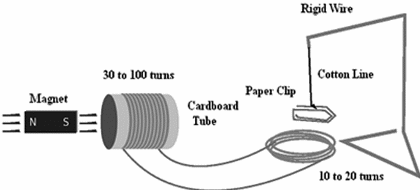Note: this article was included in my book Science Fair and Technology Education Experiments publishedin USA in 2014.
Figure 1 shows the complete circuit for the experiment, and how the individual parts are assembled. Some skill to handle the small parts is necessary.

The first coil is wounded on a cardboard. The second is a coreless coil having 10 to 20 turns and placed right under the paper clip or iron needle. The needle or clip is kept over the coil by a cotton line.
The Experiment
Moving the magnet quickly inside and outside the coil, the force lines of its magnetic field cut through the turns of the coil, inducing a voltage. This voltage causes a current that flows through the second coil creating a magnetic field.
This field acts on the clip or needle generating a force that moves it. The change of position of the needle or clip demonstrates the induction phenomenon.
It is important to show that the induction is a dynamic phenomenon and occurs only when the magnet is moving inside and outside the coil. When the magnet is still inside or outside the coil, no induction is produced.
The coils must be as far apart as possible from one another to avoid the influence of the magnet directly on the clip or needle. Extending the wire from the connection is recommended if you notice this influence.
The experiment
Put the permanent magnet at the end of a rod to make it easier to move it inside the tube. Then, quickly introduce and remove the magnet from the coil observing the needle or clip. They must move to monitor the presence of the induction. Show that a still magnet, even inside the coil, doesn’t create current.
Suggestions
1. You can replace the Galvanometer made with the needle or clip by a common Galvanometer in the lower AC voltage scale (Volt 1.5 or Volt 3.0). Prefer an analog Multimeter since you can better observe the induction by the needle oscillation.
2. Show that inductions also occur if the magnet is still and the coil move near it, cutting through its magnetic field force lines.
Competition and Challenges:
The challenge is to find the project that can power a LED connected to the coil, only using the permanent magnet. Try to increase the number of turns to achieve higher voltages. Use the coil of a small transformer from where the core was removed.
20 m of enameled wire—gauge 28 to 32 AWG
1 small permanent magnet
1 magnetized iron needle or paper clip
1 piece of cardboard or wood (15 x 15 cm)
1 cardboard tube with a diameter of 1 cm and a length of 3 to 4 cm (diameter must be enough to allow the permanent magnet to slide free inside)
1 piece of cotton thread
30 to 40 cm of plastic covered wire
Glue, adhesive band, tools, etc.
Questions
1. Explain how the induction phenomenon works.
2. Compare this experiment with the operation of dynamos and alternators. Find more information on the Internet.
3. Explain why the magnet must move inside and outside the coil to create voltage in the circuit.




